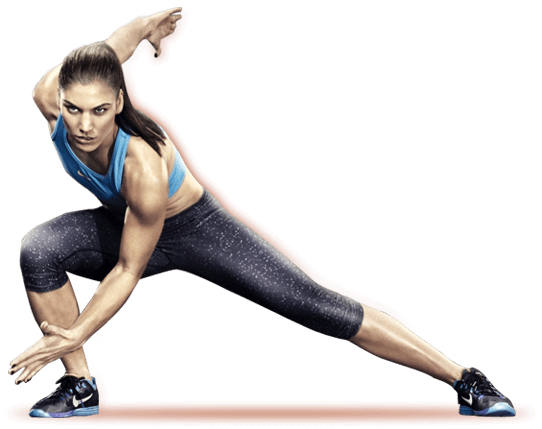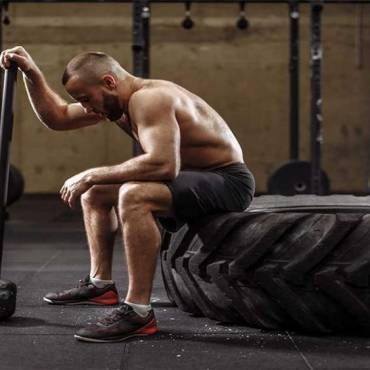You aren’t training hard enough (and how to fix it)
From Intermediate to Advanced
The Rundown
Sorry to say, chances are you are flat out poor at assessing your own intensity. This is a big deal considering the most important factor for maximizing strength and hypertrophy is hard work.6 Even experienced trainees have difficulty distinguishing between discomfort and the feeling of challenging their muscles to the point they are optimally stimulated.
Consequently, I’ve found the biggest challenge on the fitness side that separates advanced athletes from life-long intermediates is learning to go beyond these initial feelings of discomfort. Almost every athlete perceives discomfort as more significant than it actually is and our natural instinct is to avoid it at all costs. But if you want to reach your full potential, you better start prioritizing intensity and recovery.
The reality is most people quit too early. The “mental toughness” or ability to accurately gauge exertion that accompanies pushing your limits is a learned skill. This is good news because it can be learned. The issue then is finding the right balance between sufficiently pushing yourself to progress and assuring your ability to consistently recover from your training.
Many experienced coaches are unaware of how prevalent this issue is, and particularly how error-prone our coaching methods are for conveying proper intensity. This article addresses not only these issues for individual athletes, but provides a systematic approach for coaches to better progress their trainees.
Where are you getting caught?
The main problem is that gauging intensity is not intuitive for most people. New to intermediate trainees drastically sell themselves short on how much weight they can move or how hard they can go. When given a standardized weight and asked to predict the number of repetitions they can complete before reaching muscular failure, trainees routinely under-estimated their ability by ~3 reps on average (but sometimes their predictions can be off by as much as 11 reps).1
When allowed to self-select weight, athletes routinely choose significantly lighter loads than they are capable of. When trainees were asked to choose a weight they believe they can move for a 10-rep-max on bench press to failure, they routinely completed ~5 extra reps due to under-estimating the weight they should use.2 In some cases, the self-selection error was so far off they were able to complete 11 reps more than their target. They were attempting a load that allows more than double their intended reps.
As few as 20% of resistance trained individuals prove to accurately estimate their true limit within an acceptable margin of error.2 This leads to performing excessive volume or does not provide an adequate challenge when given a prescribed number of reps. Not only does this slow or stall their progress, it can actually make the issue worse because resistance training performed with a light load until failure induces higher degrees of effort, discomfort, and displeasure without increasing effectiveness.3
By choosing the lighter weights, they are actually increasing displeasure without increasing effectiveness. This is where the use of perceived exertion can be deceiving. Many incorrectly associate extreme displeasure and muscle soreness with a good workout. Some even thrive on it, but it’s not necessarily optimal. Additionally, the more repetitions that someone performs the more inaccurate a person is at estimating when they will reach failure.4
Finding a starting point
We have two issues at play regardless whether our goal is to gain size or strength: we want to sufficiently push ourselves to near failure yet at the same time we don’t want to push ourselves so far that we hamper our ability to recover. Now, there is room for taking targetted sets to failure in a proper training program, but a good rule of thumb for the majority of our training is to shoot for 1-3 reps short of failure (per working set) to achieve that sweet spot of adaptation benefits while also minimizing unnecessary hits to recovery. Luckily, there are multiple ways we can learn to do this, but the technique used is slightly different depending on what type of program we are following.
There are 3 main ways programs tend to identify intensity: percentage of 1rm, RPE (or rating of perceived exertion), and RiR (or reps in reserve)…with RPE and RiR being related. As a crash course in RiR, an RiR of 0 (RPE of 10) would mean you have zero reps in reserve, zero reps left over after the prescribed number of reps. It signifies the maximum load (weight) you can use to perform the number of reps prescribed. 2 RiR (~RPE of 8) would represent a weight you can only complete 2 more reps AFTER your target number of reps. Any subsequent reps would reach momentary muscular failure if you have chosen the correct load. If you wish to learn more about RPE or RiR, I recommend you look up one of the various resources online that covers these extensively.
So how can you make each of these systems work as accurately as possible?
For percentage work, you simply follow whatever program you are running…but since percentages do not take into account individual variation or how you are feeling that day, it may be the least adaptable training protocol on paper (and in practicality). It doesn’t allow the athlete to autoregulate quite as well as RPE or RiR over a variety of rep ranges without further guidelines.
The accuracy for percentage-based work tends to decline very quickly the farther away a person goes from their one rep max, based on their training experience, and based on the specific exercise in question. It’s rather accurate from 1-3 reps (or roughly 90% 1rm and above). At 70% 1rm, participants were found to vary between 18 to 40 reps.7 Even the most advanced weightlifters in the study exhibited a nearly 6 rep spread. That is quite the range!
The proximity to failure for percentage-based work has the largest variance of all intensity programming methods due to individual differences between not only the trainee’s genetics and their training backgrounds, but the specific exercise itself, tempo, focus of attention, and rest periods used.6,8-11 Prescribing sets with a certain number of reps at a specific percentage of 1RM does not standardize the stimulus. It can absolutely have its applications; it is particularly suited for lower rep strength progression, but athletes should understand that following the exact formulas may not always be the best way to identify their individual ability.
To save myself from the hordes of Power and Olympic lifting coaches now lumbering towards my house in a blind rage, I feel motivated to mention one way to reconcile this would be to consider using a hybrid model where the coach or athlete employs percentage-based work for roughly 1-5 rep sets, then switches to an RPE/RiR style routine for other rep ranges. This would allow the familiarity of the percentage-based programming without suffering some of the downsides. Ultimately a coach will want to program in the manner they feel will best help a particular athlete for their specific goals.
Because of these potential drawbacks, I gravitate towards RPE/RiR (and RiR in particular with my athletes since it appears reliable over a wide range of training experiences12). As discussed earlier, the majority of people tend not to lift heavy enough, so most should err on the side of a slightly heavier load for a given number of reps than they would initially predict. This will allow you to fall into your true ability range more accurately. If you are following programming that gives you a set number of reps, challenge yourself to use the heaviest weight you believe you can…then add 5lbs (or more depending on the lift). You can always dial it back if you find you aren’t able to hit the target number of reps or if you believe this is significantly beyond the RPE or RiR indicated.
When following modern training protocols such as reps in reserve (RiR) for intensity, I find a helpful trick is to use your first two weeks in a new training block to take targeted sets to failure as a way to verify you have chosen the proper weight to progress for the rest of that cycle. Let’s assume you plan to train in 2 RiR. You select a weight you believe you can do for 2 reps beyond your prescribed number of reps (any subsequent reps should reach failure if you have chosen correctly). You lift this weight for as many reps as it takes for momentary muscular failure. If you achieve more than 2 reps beyond your target number, then it’s time to add some weight because you undershot with your guesstimate. If you fail on the third rep beyond your prescribed number, then you are dead on. Easy fail-safe way to test RiR.
An option for those following RPE is a novel system that I’ve seen Brad Loomis pioneer where he couples the ratings of perceived exertion with video recordings to monitor the speed of an athlete’s lift. The following is a diagram from one of his articles on the matter. If this is something you are interested in pursuing, I recommend you check out his RPE article for further information.
If you are still concerned, the vast majority of people that go to the gym are more than happy to be your spotter as long as you ask politely…and you know that powerlifter has the strength and time between sets to help you out! Many times this is the only confidence boost you need to take lifting beyond your normal limits into the proper range. Ask someone for a spot and intentionally take yourself to momentary muscular failure. Now you have a rough gauge. Dial that back to whatever your targets are, then start progressing from there the next training session.
The important concept throughout all of this is that you are likely, at least initially, a lousy gauge of how capable you are. Dial in your training with a test period at the beginning of a training cycle. There are ways to test your absolute limits safely, so take advantage of those when you start a new training block to establish a baseline that is better than a guesstimate. Then progress from there.
Monitoring progress
Now that you have some tricks to identify a good starting point, you have to take into account ways to monitor both the effectiveness of your training and the fatigue it creates, which directly affects your recovery from session to session. I suggest keeping four things in mind: 1) Perceived Exertion 2) Soreness & Fatigue 3) Performance 4) Pumps.
Many coaches use similar systems; I am certainly not the first to employ these. These are markers I’ve learned from other skilled coaches, through personal experience, and through observation of what has worked with my own athletes over time. It isn’t the particulars that matter, but finding what produces the most reliable results for you and/or your athletes. Feel free to modify these as you see fit.
- Perceived Exertion: You want to see the session feeling moderately challenging at the beginning of a training block with difficulty ramping up towards the end of the cycle as progressive overload comes into play.
- Soreness and Fatigue: You want to look for signs of modest post-exercise soreness or fatigue in the muscles that tend to get sore, particularly in the beginning of a new training block. Since not all muscles tend to get sore for each person, this is not a definitive sign of progress, but it is one that can be monitored. Keep in mind to also watch out for cases of extreme soreness and fatigue between workouts as that is a sign that volume or intensity should be adjusted to allow adequate recovery between sessions.
- Performance: This should at least be maintained or slowly progressed over a cycle. A realistic expectation for more advanced trainees may be signs of progress over multiple cycles.
- Pump: There may be signs of a residual pump after training a target muscle. This is similar to gauging soreness in that individuals may not have this as significantly in certain muscles. Some muscles will be more prone to a pump than others, but as long as you realize this you can still monitor the effect.
Now, just as scale weight doesn’t tell the whole story in a weight loss phase, each of these on their own does not tell the whole story of progress. But combined they paint a decently clear picture.
Wrap it up
Both too little and too much intensity can prevent you from achieving your full potential. This means it is key to balance both pushing yourself hard enough and monitoring your recovery from session to session. Use a few of the methods I’ve outlined here to find your starting point, and then monitor both progress and fatigue moving forward.
Olson put it nicely when she said: “When you learn to withstand discomfort and push through something difficult, it gives you confidence. It’s empowering and shows you that you can do more than you likely thought you could.”5
Citations
- PMID: 29204323
- PMID: 29112055
- PMID: 31499564
- PMID: 30747900
- Olson (2015). outsideonline.com/health/training-performance/training-when-youre-tired-will-make-you-better-athlete/
- doi.org/10.1016/j.cophys.2019.04.006
- doi: 10.5604/20831862.1099047
- DOI: 10.1080/17461391.2018.1450898
- doi: 10.2478/hukin-2018-0034
- DOI: 10.1515/hukin-2017-0077
- DOI:10.1088/1742-6596/1529/2/022008
- doi: 10.1519/JSC.0000000000003952











